 Argentina (1976-Present)
Argentina (1976-Present)
Infantry Fighting Vehicle/Armored Personnel Carrier – Around 124-216 Built
Whilst the Tanque Argentino Mediano (TAM) has become the most celebrated armored vehicle of the Argentine Armed Forces, the Vehículo de Combate de Transporte de Personal (VCTP) has, perhaps unfairly, not achieved such fame. Despite the fact that the development of both vehicles took place at the same time, much information regarding the history of the VCTP is hard to come by. This is quite surprising given that the VCTP is the only vehicle of the TAM family to have seen service outside of Argentina.
Context – Plan Europa
Argentina had remained neutral during most of WWII. Although it declared war on Germany and Japan in March 1945, the country had previously held strong sympathies towards Germany. On June 4th, 1943, a coup took place which, in time, gave rise to Colonel Juan Domingo Perón, the most divisive character in Argentinian history, becoming the country’s president in 1946.
In military terms, Argentina had a large army for its region. Taking advantage of the end of WWII and the availability of a large stock of surplus and extremely cheap US and British armored vehicles, Argentina became a considerable military power in the zone. Between 1946 and 1949, Argentina purchased or acquired at least 250 Universal Carriers, around 360-400 Shermans (M4A4’s and Firefly tanks), 18 Crusader II, Gun Tractor Mk I, 6 M7 Priests and 320 M-series Half-tracks.
By the mid-1960s, these vehicles were becoming obsolete and a plan to replace them was put into action. Led by General Eduardo J. Uriburu, the intention of this project was to modernize and diversify Argentina’s armored vehicles with the purchase of European vehicles. The ultimate goal, however, was to avoid dependence on any foreign power to provide armored vehicles. As set out by the Estado Mayor General del Ejército (EMGE), the plan would be to not only acquire the vehicles but also the authorization to produce them under license in Argentina. Before the end of the decade, the purchase of 80 AMX-13’s armed with a 105 mm gun, 180 AMX VCI Armored Personnel Carriers, 14 AMX-155 F3 and 2 AMX-13 PDP (Poseur De Pont) Modèle 51’s from France and around 60 or 80 Mowag Grenadiers and possibly a number of Mowag Roland from Switzerland was agreed. Additionally, 60 Mowag Rolands and 40 AMX-13’s were assembled under license in Argentina.
The main purpose was to find a modern and adequate replacement for the Sherman Firefly as the main battle tank for the Argentinian armed forces. In 1973, EMGE set out the requirements for a medium tank to equip Argentinian forces from the 1980s onwards.

Enter Thyssen-Henschel
The company which met EMGE’s requirements for a new tank was the West German Thyssen-Henschel. This would be an agreement for co-production and technology-sharing with Argentine engineers collaborating from the very beginning.
At some point, once Thyssen-Henschel had got involved, the West German company decided to also produce an Infantry Fighting Vehicle/Armored Personnel Carrier which would become the VCTP. It was built with the purpose of mechanizing the infantry whilst also being able to provide fire support.
It was agreed by both parties that, for ease of production, speed of development, and presumably cost, it was best to base the new vehicles on pre-existing and tested technology. To that end, the Marder Infantry Fighting Vehicle, which equipped the West German Army, was chosen as the basis for the new vehicles. In essence, the VCTP is an up-gunned and higher troop capacity Marder.
Thyssen-Henschel finished the first VCTP in 1977.
Trials
The VCTP was tested at the Thyssen-Henschel facilities along with two TAMs before being sent to Argentina for further testing and evaluation under the supervision of EMGE. The vehicle was shown to the public for the first time on May 25th 1977. Thyssen-Henschel built another prototype and improved it with more expensive equipment. This vehicle, the TH-302, was intended for the export market, but unfortunately for the West German company, it was unable to find any additional customers. It is very important to establish that, like the TH-301 and the TAM, the TH-302 was not a prototype for the VCTP, but rather a development of the prototype by Thyssen-Henschel.
Over the next 2 years, the VCTP and TAM drove almost 10,000 km over all the types of terrain and in all the climates found in Argentina. For context, Argentina has very varied geography: mountainous and very high peaks in the west, arid deserts across the middle of the country, wetlands in the northeast and polar tundra in the south.

The tests were deemed very satisfactory and, during the trials, EMGE ordered the construction (though this was most likely more of an assembly job) of 4 more prototypes (2 TAM and 2 VCTP) in the General San Martín and Río Tinto factories to carry out more tests and evaluate the factory’s capacities before producing the serial version. One of the main changes from the prototype to the serial production version was the reduction of the crew from 3 to 2, with the vehicle’s commander giving way to an extra infantry trooper. Additionally, the rear weapons station was changed.

Towards Serial Production
EMGE wanted to produce, or at least assemble, the new vehicles in Argentina. So, a whole new infrastructure had to be created, incorporating state-run enterprises and also private companies. Although the industrial development Argentina put into motion was mainly for the purpose of assembling and producing elements of the TAM, due to the nature of the VCTP, which used the same components and was based on the same chassis, these were also essential in the production of the VCTP. For example, the General San Martín factory built the hulls for the VCTP and TAM, and Río Tercero was put in charge of building the turrets and armament. The Argentinian Company Bator Cocchis SA produced the torsion bars and rubber pads. However, many components were still manufactured in West Germany or other countries, with several different companies working on different elements, including:
– Motoren- und Turbinen-Union (MTU) GmbH – engine
– Renk – transmission
– Diehl – tracks
– Standard Elektrik Lorenz – communications
– Carl Zeiss – optics
– Tensa
– Bertolina
– Pescarmone and FIAT – some elements of the undercarriage
In all, according to Mazarrasa and Sigal Fagliani, by 1983, 70% of all TAM components were being produced in Argentina, so it can be estimated that a similar percentage was also applicable to the VCTP.
In March 1980, with the objective of having one company that would coordinate the whole program, Tanque Argentino Mediano Sociedad del Estado (TAMSE) was created. TAMSE was established as the main contractor of the TAM and VCTP and given the task of overseeing the final assembly, delivery integration of the tanks into the army, trials, homogenization of the optics and armament and potential exports.
TAMSE was given a 9,600 km2 covered assembly plant in Boulogne sur Mer, just outside Buenos Aires. The installations at Boulogne sur Mer also housed two warehouses to stock vehicle components, offices, laboratories for quality control evaluation, engine test benches, a pit for trials and a shooting range.
Production had begun beforehand in April 1979, with most components coming from West Germany and assembly taking place in already existing factories. The initial order was for 200 TAM and 312 VCTP, though this would not initially be fulfilled.
Numbers Built?
One of the hardest facts to establish about the VCTP is the exact number built, as there are widely differing figures. In his book La Familia Acorazada TAM, Spanish author Javier de Mazarrasa states that, in 1995, as many as 216 VCTPs and Vehículos de Combate Puesto de Comando (VCPC) had been built. A much more conservative estimate is given by Juan Carlos Cicalesi and Santiago Rivas in TAM (published in 2012), who state that only 124 were built, in addition to 9 VCPCs.

Design
External Appearance and Armor
As stated previously, externally, in appearance and design, the VCTP is very similar to the Marder IFV. The frontal plate is at a pronounced 75º angle and the sides and rear plates are positioned at 32º. At the front of the tank, on each side, are headlights. Behind these, also on each side, are wing mirrors. On each side of the front-middle section of the hull are a set of 4 Wegman 77 mm smoke launchers.
In the center of the vehicle is the turret. On the front of the right-hand side of the turret is a small hatch to dispense used cartridges. On top of the turret are two hatches, one for an infantry commander and the vehicle’s gunner.
The VCTP’s armor is made out of electrically welded nickel-chromium-molybdenum steel. The front plate is 50 mm thick and the sides and rear 35 mm. Turret armor is 35 mm at the front.
Additionally, the VCTP is equipped with an NBC protection system allowing the crew to operate in a contaminated area for up to 8 hours. The NBC system feeds the main and driver’s compartments with filtered air that can absorb solid or gaseous elements from poisonous or radioactive substances. The vehicle is able to operate in very harsh temperatures, from as low as -35ºC to as much as 42ºC, ideal for the varied terrain in Argentina. There is also an automatic fire extinguishing system which can also be manually triggered from the interior or exterior.
Armament
The VCTP has a variety of armaments. Its main gun is located in the fully rotating turret and consists of a Rheinmetall Mk 20 Rh-202 20 mm autocannon, which has a total length of 2,612 mm (2,002 mm barrel length) and a weight of 75 kg. The gun’s depression is -11º, whilst its elevation is +60º. Effective firing range is deemed at 2,000 m, though maximum firing range far exceeds this. The Mk 20 Rh-202 fires 880 rounds a minute, which can be increased to 1,030 rounds a minute on quick-fire mode.
Some sources (Sigal Fagliani) suggest that Argentina encountered issues with Rheinmetall regarding a weapons embargo and turned to the Swiss Oerlikon KAD 20 mm autocannon, the new name of the Hispano-Suiza HS.820 following Oerlikon’s purchase of Hispano-Suiza, as the main weapon for the VCTP. Regardless, the Oerlikon KAD and the Rh-202 could fire the same projectiles.
A total of 1,000 cartridges of two types of ammunition for the main gun are carried in the VCTP: the High Explosive DM81 and the Armor-Piercing DM63. These are placed in ammunition clips with 325 DM81 cartridges and 75 DM63 cartridges.
| Name | DM81 | DM63 |
| Muzzle Velocity (m/s) | 1,045 | 1,150 |
| Weight (g) | 120 | 108 |
The fire control system for the main gun on the VCTP is hydraulic. The gunner has a Zeiss PERI-Z11A1 sight with ×4 magnification and an LRP-2100 panoramic periscope.
Secondary armament consists of two 7.62 mm FN MAG 60-40 machine guns, one placed on top of the turret and a second-placed in a TPA-1 remote-controlled weapon station at the rear of the vehicle. The 7.62 × 51 NATO-standard ammunition for the machine guns has a muzzle velocity of 840 m/sec and a firing range of around 1,200 m. A total of 5,000 rounds are carried inside. Additional weaponry for the crew includes their personal weapons and 9 hand grenades.
Suspension and Undercarriage
The VCTP retained the suspension and running gear of the Marder 1, a torsion bar-type suspension with six rubber-tired paired road wheels and three return rollers on each side. The first, second, fifth, and sixth road wheel stations have hydraulic shock dampers.
The tracks are of a Vickers system, each track consisting of 91 links with rubber tank treads. These can be substituted by snow cleats if required.
Interior
The interior of the VCTP is divided into two main sections, with the frontal section being further sub-divided into two subsections. The bigger of these subsections, occupying 2/3 of the frontal space, houses the engine, whilst the smaller one is for the driver and driving mechanisms. There is a hatch above the driver’s position and three episcopes, and another one behind for one of the passengers. The whole section of the frontal hull covering the engine can be opened for engine maintenance.

The bigger rear section occupies the central and rear part of the tank and is where the 10 infantry (1 commander and 9 troopers) the VCTP carries sit. Bizarrely, the infantry platoon commander also acts as the vehicle’s commander and usually sits in the turret, where there are seven episcopes and one periscope to observe the vehicle’s surroundings. The infantrymen are seated on a central bench back-to-back with five on each side. Furthermore, they can provide fire from inside the vehicle through the three hatches placed on each side of the hull. One of the infantry also has the task of operating the TPA-1 remote-controlled weapon station at the rear. This role is assisted by four periscopes and 3 episcopes, crucial to know where and what to fire at.
At the rear of the vehicle, there is a small door for the crew and infantry to enter and exit and to replenish ammunition and other things the VCTP may need.


Communications are by means of VHF SEL SEM-180 and SEM-190 systems and a SEL SEM-170 radio-receptor.
Engine and Performance
The engine on the VCTP is the MTU MB 833 Ka 500 diesel engine, a six-cylinder rated at 537 kilowatts (720 hp) at 36.67 revolutions per second or 2,200-2,400 revolutions per minute. This gives the vehicle a power-to-weight ratio of 17.6 kilowatts per tonne or 24 hp per tonne.
The engine is kept cool by two fans at its rear powered by a 33 hp engine of their own.
The gearbox on the VCTP is the HSWL 204 automatic planetary gearbox with torque converter and four forward/four reverse gear ratios. The first three are epicyclic gear trains (also known as planetary gears) and the fourth is a clutch disc.
The maximum road speed is 75 km/h forwards and backward. Off-road or cross-country speed is limited to 40 km/h. The VCTP carries 650 liters of fuel for a maximum range of 590 km. This can be supplemented with two 200 liter tanks for a total of 1,050 liters which extends the maximum operating range to 840 km. However, these are not often added on the VCTP. Other capacity fuel tanks have also been used.
Among other performance indicators, the VCTP can overcome 60% gradients, 30% side slopes, 1 m tall obstacles and 2.9 m trenches. When it comes to fording, it is capable of fording 1.5 m deep waters without preparation, increased to 2 m with preparation.
Operational Service
When production began in April 1979, it was expected that 200 TAM and 312 VCTP would be completed by April 1985, when the project was expected to terminate. However, economic difficulties meant that production was stopped at 150 TAM and 100 VCTP in 1983. Additionally, 70 unfinished vehicles were left in the factory. The first serial production vehicles left the factory in 1980.
Having built the facilities and invested a considerable amount of money but with production terminated, it was decided to try to seek success in exporting both types of vehicles. However, several deals with Arab and Latin American countries fell through and, to date, no vehicle has been exported. In the meantime, the Ejército Argentino incorporated 20 TAMs and 26 VCTPs which had been built for export to Peru.
The VCTP would see its combat debut in January 1989 during the attack on La Tablada barrack in Buenos Aires province. In this incident, the left-wing Movimiento Todos por la Patria (MTP) [Eng. All for the Fatherland Movement], which was heavily inspired by the Nicaraguan Sandinistas, took over the La Tablada barracks of the Regimiento de Infantería Mecanizado 3 on January 23rd, 1989. There is a lot of controversy surrounding the reasons behind this attack, but during the subsequent court hearings, MTP members claimed that they were attempting to prevent another ‘carapintada’ military coup, of which there had already been three between April 1987 and December 1988. Others would claim that the attack on the barracks was a failed attempt to instigate a popular uprising. To quell the revolt, the VCTPs and infantry of the Regimiento de Infantería Mecanizado 7 «Coronel Conde» were sent to La Tablada. In the end, after several hours of fighting, MTP was defeated after losing 32 fighters.
 Two VCTPs belonging to Regimiento de Infantería Mecanizado 7 «Coronel Conde» which intervened during the assault on La Tablada barracks in January 1989 – source: Cicalesi & Rivas, p. 60
Two VCTPs belonging to Regimiento de Infantería Mecanizado 7 «Coronel Conde» which intervened during the assault on La Tablada barracks in January 1989 – source: Cicalesi & Rivas, p. 60
Extract of a video showing a VCTP and infantry advancing on La Tablada barracks in January 1989
The VCTP would also see some action during one of the ‘carapintada’ military coups which shook Argentina between 1987 and 1990. In the last of this series of coups (December 3rd, 1990), rebellious forces under Captain Gustavo Breide Obeid took over a series of military installations, among them TAMSE. The officer who took the factory, Colonel Jorge Alberto Romero Mundani, ordered 9 or 10 TAM in the factory to head to Buenos Aires. On route, the tanks ran over a group of civilians, killing 5 of them before heading off to Mercedes. Seeing that the attempted coup was heading for failure, Romero Mundani committed suicide, one of 8 military casualties of the failed coup.
In 1992, 15 VCTPs were sent to Yugoslavia as part of the United Nations Protection Force (UNPROFOR). The vehicles were painted in UN white and departed Argentina on March 24th, 1992 on the ship ARA Cabo de Hornos, arriving in Bar, in modern-day Montenegro, in May. Within Yugoslavia, they were sent as part of the Batellón Argentino to Western Slavonia, on Croatia’s northern border with Bosnia. En route to Slavonia, when the contingent was outside Osijek, two VCTPs were shelled by enemy forces resulting in the deaths of some civilians. In October 1982, VCTPs were deployed to prevent Croat militias from attacking Serb civilians. Most of the actions in late 1992 involved controlling the large groups of refugees. No exact details are known of the exact role the VCTP’s played, but starting in January 1993, the Batellón Argentino and other UNPROFOR units in the sector were kept busy during the Croat Operation Maslenica to retake territory in northern Dalmatia and Lika from Krajina Serb forces.
Unfortunately, not much more is known about their actions in the crumbling former Yugoslavia, but they finished their service and returned to Argentina in 1995 when UNPROFOR was ended and replaced by three different missions.


Since then (as of April 2020), the VCTP has served alongside the M113 as the main armored personnel carrier of the Ejército Argentino. In 2008, a small number of VCTPs were refurbished by Comando de Arsenales in the former TAMSE installations at Boulogne sur Mer.
As of 2019, there was a plan to modernize the VCTP by bringing some of its components up to date, including its hydraulic, electronic and optic systems, fire control system and ballistic computer. Exact details are unknown and neither is how many, if any, have been modernized.

Organization
The VCTP equips the Regimentos de Infantería Mecanizada of the Ejército Argentino, in other words, the mechanized infantry regiments. Those regiments equipped with VCTPs, such as the Regimiento de Infantería Mecanizado 7 «Coronel Conde», have two companies each divided into three sections, with 4 VCTPs per section and an additional one for the company commander. This is a total of 29 VCTPs per regiment. Additionally, each regiment is led by a VCPC and is accompanied by 4 Vehículos de Combate Transporte Mortero. Other mechanized infantry regiments use M113’s under the same organization.

Export Failure
As with the TAM, once production of the VCTP was terminated two years early, EMGE unsuccessfully attempted to export the vehicles. Their intention was to try to make TAMSE financially viable to recoup the heavy investment in its set-up and infrastructure.
In mid-1983, Peru made an effort to purchase 100 TAMSE vehicles (TAM and VCTP). However, financial reasons meant that they canceled the order and stuck with vehicles already in service. The 20 TAM and 26 VCTP already built for this delivery were transferred to the Argentinian Army.
In 1984, Panama ordered 60 vehicles, again, divided between TAMs and VCTPs. However, this would not materialize. It is possible that the sources about this are incorrect, and that the tanks for Panama were actually for Iran.
The closest Argentina got to selling a TAMSE vehicle was to Ecuador in 1988-89. Ecuador was looking for a tank for its armed forces and had a competition between different tanks to inform and determine their decision. The TAM’s competitors were the Austrian SK-105, the American Stingray, and the French AMX-13. The TAM was the comfortable winner, scoring 950/1000 points. The deal was going to be for the purchase of 75 vehicles (TAMs, VCTPs and VCRTs) for US$108 million. It fell through, according to Sigal Fagliani, because of the threatened closure of TAMSE. In the end, Ecuador did not purchase any tanks.
Variants
Since its inception, the VCTP has played a variety of roles in the Argentinian Army. Mainly due to financial constraints, purpose-built or modified vehicles for those roles have been unavailable.
Ambulance
Originally, several VCTPs had their turrets removed, thus becoming Vehículo de Combate Ambulancia (VCA). In 2001, there was an effort to create a purpose-built ambulance vehicle, the VCAmb, but after only one wooden mock-up, the project was canceled. As a consequence, the VCTP continued to be used in this role, either without its turret or just without the main armament. It is possible only the driver is retained, as the gunner is no longer needed. In addition, in its ambulance configuration, the VCTP, or VCA, carries two medics and medical equipment. The vehicle carries 4 people on stretchers, two on stretchers and four sitting down, or eight sitting down.

Mine Clearing
All vehicles in the TAM family, more often than not, the VCTM, can carry an Israeli-built RKM mine-roller for mine-clearing duties.
Engineering
A small number of VCTPs have been repurposed as engineering vehicles by having their turrets and TPA-1 rear weapons platforms removed. The interior has been reconditioned so as to act as a small workshop. Additionally, a ladder has been added on the left-hand side of the hull.
Derivatives, the TAM family
One of the most distinguishing factors of the TAM family is how flexible a platform it is, having spawned several derivatives, including recovery vehicles, self-propelled guns and mortar carriers. Whilst this flexibility was not one of the initial requirements set by EMGE, it was very much appreciated and was in line with the initial wishes of the Argentinian military authorities, to reduce or limit the reliance on foreign vehicles. Several of the vehicles belonging to the TAM family seem to be direct derivatives or variants of the VCTP itself.
VCTM (Vehículo de Combate Transporte Mortero)
Produced from 1980’s onwards, it was the first TAM family vehicle to have been designed in Argentina. Eliminating the turret of a VCTP, it carries a 120 mm Brandt MO-120-RT mortar which fires through the hole where the turret once stood. 36 VCTMs have been built and are still in service.

VCPC (Vehículo de Combate Puesto de Comando)
A variant of the VCTP developed in 1982, the VCPC is a command vehicle that substitutes the turret of the VCTP for a hatch for the commander. It has additional radio and communications systems and a map table in the middle of the vehicle. Only 9 have been built.

VCCDF (Vehículo de Combate Centro Director de Fuego) and TAM VCCDT (Vehículo de Combate Centro Director de Tiro)
Two identical vehicles derived from the VCTP were built for artillery fire control in the mid-’90s. The difference between them comes down to their roles; whereas the VCCDF is used by artillery groups, the VCCDT is used at the battery level. They were built in small numbers, there are 2 VCCDFs and 4 VCCDTs.
Conclusion
The VCTP has played an important role in the Ejército Argentino since it first entered service at the beginning of the 1980s. It has also been the only TAM family vehicle to have seen service outside of Argentina given its role as part of the Batellón Argentino in Yugoslavia. However, whilst not as urgently as the TAM, the VCTP should soon be replaced with more modern equipment, as it is heavily based on the 1960’s technology. The chances of this happening are slim, as there is no imminent threat to Argentina where the VCTPs age would show, and the limited budget will probably be used on finding an alternative to the TAM. As such, it is likely that the VCTP will continue to see service with Argentina for the foreseeable future.

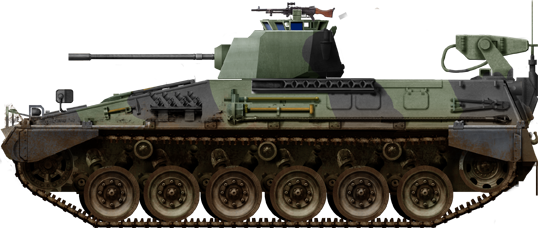
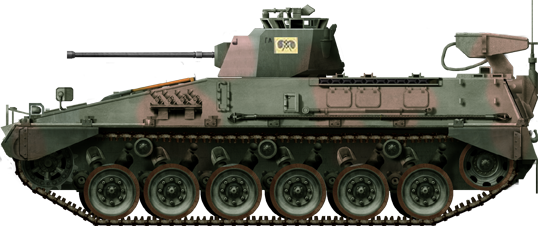
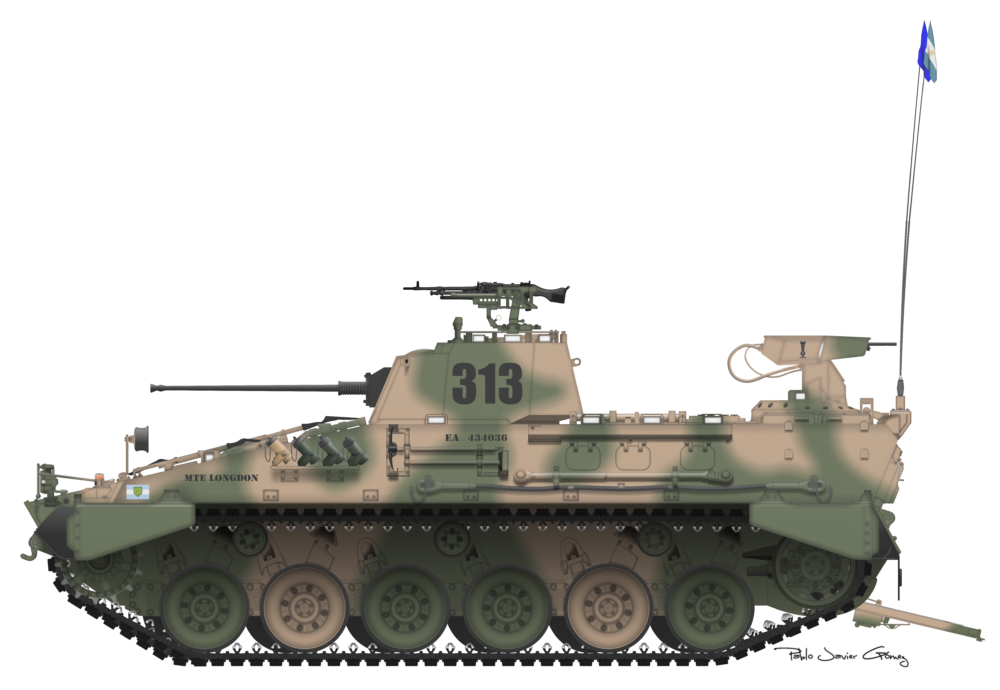
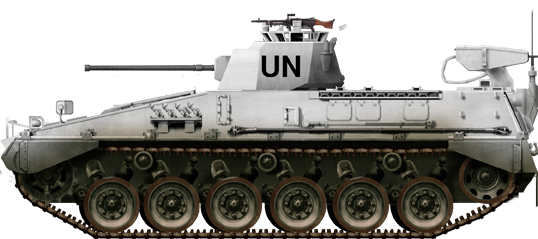
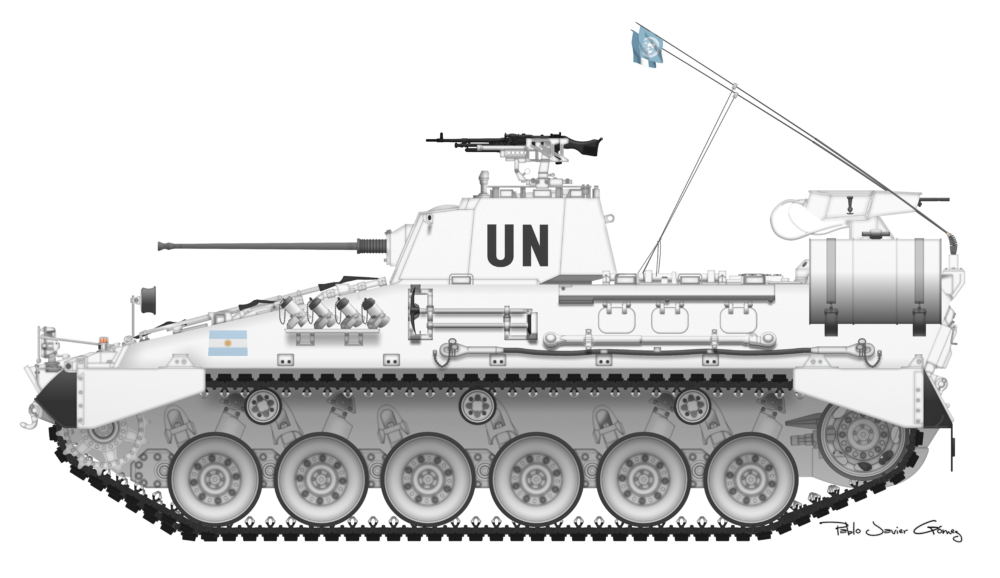
Bibliography
Anon., “Advierten que Panamá podría embargar la fragata Libertad,” Clarín, 09 September 1999
Anon., Military Vehicle Forecast, TH 300 (TAM – Tanque Argentino Mediano) and TH 301 [archived report]
Guillermo Axel Dapía, El Desarrollo de la industria de blindados en Argentina y Brasil: un estudio comparado de integración económico-militar, Thesis, Universidad de Buenos Aires, 2008
Javier de Mazarrasa, La Familia Acorazada TAM (Valladolid: Quirón Ediciones, 1996)
Marcelo Javier Rivera, El Tanque Argentino Mediano – TAM, Universidad Federal de Juiz de Fora, 2008
Michael Scheibert, SPz Marder und seine Varianten (Friedberg: Podszun-Pallas-Verlag GmbH, 1987)
Ricardo Sigal Fagliani, Blindados Argentinos de Uruguay y Paraguay (Ayer y Hoy Ediciones, 1997)
VCTP Specifications |
|
| Dimensions (L/w/h) | 6.83 x 3.29 x 2.68 m |
| Total weight, battle ready | 28.2 tonnes |
| Crew | 2 (driver and gunner) + 10 infantry (1 commander and 9 troopers) |
| Propulsion | MTU-MB 833 Ka-500 6-cylinder diesel, 720 hp |
| Range | 590 km without external fuel tanks |
| Armament | Main – 20 mm Rheinmetall Mk 20 Rh-202 / Oerlikon KAD Secondary – 2 x 7.62 mm NATO FN MAG 60-40 (one on top of turret, one in TPA-1 weapon platform in rear) |
| Armor | Front hull – 50 mm Side hull – 35 mm Rear hull – 35 mm Turret – 35 mm |

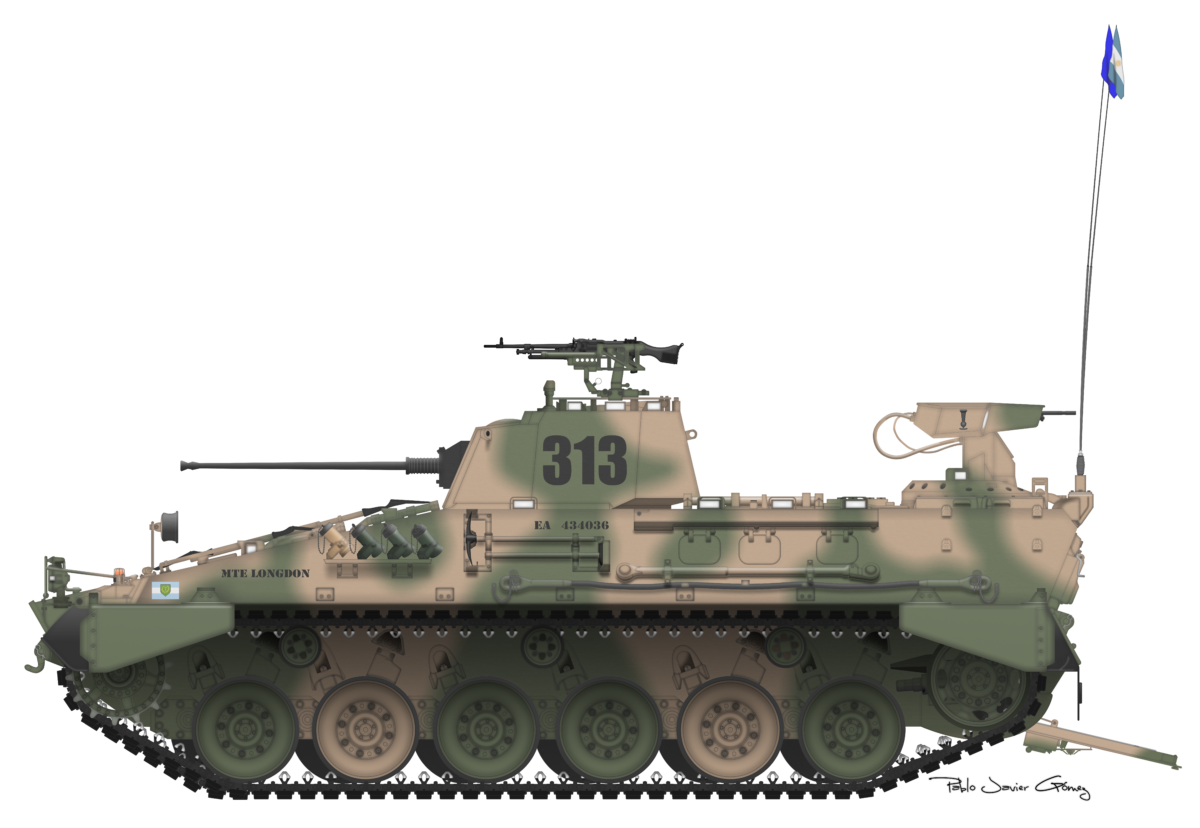
One reply on “Vehículo de Combate de Transporte de Personal (VCTP)”
“In all, according to Mazarrasa and Sigal Fagliani, by 1983, 70% of all TAM components were being produced in Argentina, so it can be estimated that a similar percentage was also applicable to the VCTP.
In March 1980, with the objective of having one company that would coordinate the whole program, Tanque Argentino Mediano Sociedad del Estado (TAMSE) was created. TAMSE was established as the main contractor of the TAM and VCTP and given the task of overseeing the final assembly, delivery integration of the tanks into the army, trials, homogenization of the optics and armament and potential exports.
TAMSE was given a 9,600 km2 covered assembly plant in Boulogne sur Mer, just outside Buenos Aires. The installations at Boulogne sur Mer also housed two warehouses to stock vehicle components, offices, laboratories for quality control evaluation, engine test benches, a pit for trials and a shooting range.
Production had begun beforehand in April 1979, with most components coming from West Germany and assembly taking place in already existing factories. The initial order was for 200 TAM and 312 VCTP, though this would not initially be fulfilled.”
To me this part is confusing chronologically. It goes from later date to earlier, saying first how all of them were assembled in one factory, then how this was an Argentinian plan and then how all components came from West Germany. Wouldn’t it make a lot more sense if chronology would flow from earliest events to latest?